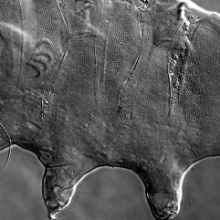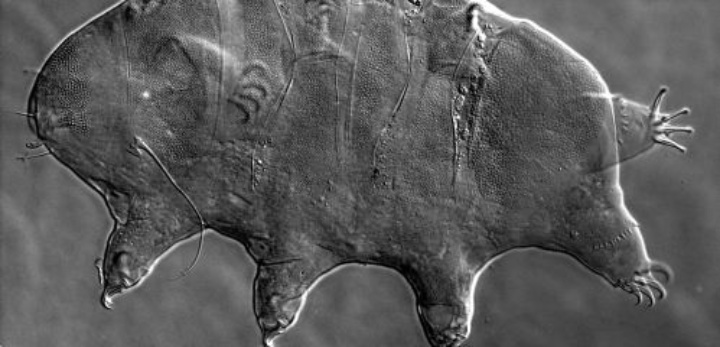They are skilled survivors like their counterparts but spotted on the body’s surface like a panther: on two excursions to the Italian and French Maritime Alps, a group working under the Stuttgart tardigrade researcher, Dr. Ralph O.Schill discovered a new type of tardigrade. The description of the Alp tardigrade going by the name of Echiniscus pardalis has now been published in the renowned taxonomical journal by the Natural History Museum in Paris.*)
As early as 2006 the Network of Excellence EDIT (European Distributed Institute of Taxonomy) prepared comprehensive inventories of lists of species in selected nature reserves to classify flora and fauna. In so doing groups of biologists helped on site to collect inventory lists of all types of flora and fauna to be found there respectively to update and complete existing species lists. The Stuttgart tardigrade researcher Ralph Schill and his colleagues visited the nature park Naturale delle Alpi Maritime on the south side of the Maritime Alps on several occasions in the course of the project as well as the national park Parc National du Mercantour bordering on the French side.
The scientists collected over 300 moss samples in which the tardigrades prefer to live. Since tardigrades have the ability to dry up in unfavourable environmental conditions and to survive in spite of this, taking samples was relatively easy: in the research areas the position of the moss was initially determined by means of GPS. Then the researchers cut off small pieces, dried them and kept them closed in coffee filter bags. In the subsequent evaluation a total of 30 different species could be identified.
However, what surprised the biologists: some of the animals showed a distinctive spot pattern on the body’s surface that could not be matched with any of the known species up to now. After extensive investigations Ralph Schill was then sure – this has to be a new species that has been unknown to date. Together with his colleague Peter Degma from Bratislava, he gave the Alp tardigrade the name Echiniscus pardalis, named after the panther pattern (Panther lat. pardalsi) under the body’s surface.
The Network of Excellence EDIT (European Distributed Institute of Taxonomy) is an alliance of 25 European institutions working in the taxonomical field and is funded by the European Union with a sum of 12 million Euros. The objective of the alliance is an improved integration of taxonomical research in Europe.
*) Degma P. & Schill R. O. 2015. — Echiniscus pardalis n. sp., a new species of Tardigrada (Heterotardigrada, Echiniscidae, arctomys group) from the Parco Naturale delle Alpi Marittime (NW Italy), in Daugeron C., Deharveng L., Isaia M.,Villemant C. & Judson M. (eds), Mercantour/Alpi Marittime All Taxa Biodiversity Inventory. Zoosystema 37 (1): 239-249.
Published by: Muséum national d'Histoire naturelle, Paris, DOI: http://dx.doi.org/10.5252/z2015n1a12
Further information:
Dr. Ralph O. Schill, University of Stuttgart, Institute for Biomaterials and Biomolecule Systems, Department of Zoology, Tel. +49 711 685-69143, ralph.schill (at) bio.uni-stuttgart.de
Andrea Mayer-Grenu, University of Stuttgart, Department of University Communication, Tel.
0711/685-82176,
Email: andrea.mayer-grenu (at) hkom.uni-stuttgart.de



